Notes
The Boys From Brazil, And Other Fallujah Stories
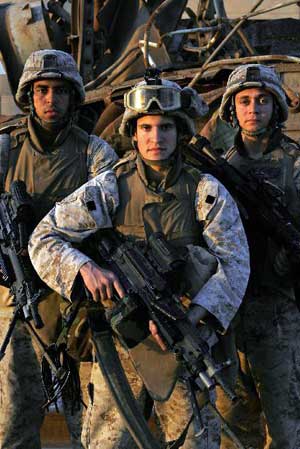
(l to r: Soldiers Mesquita, de Carvalho and Barbosa)
What’s unusual about this photo thread at Crisis Pictures (view series HERE) is the "day in a life" quality to it.
Although photographer Mauricio Lima’s first 13 shots are from December 20th, the next 12 from December 19th, and the last 4 from December 18th, it still reads like a continuous timeline beginning before dawn and stretching into the late afternoon.
The fact we are introduced to three Brazilian born marines at the outset (Lance Corporal Daniel Moreira de Carvalho, Corporal Felipe Carvalho Barbosa and then Lance Corporal Felipe Santos Mesquita) only enhances the feeling of a narrative, with these three soldiers as the protagonists. (Given this sense, it is somewhat jarring that our three heros suddenly disappear after the twelfth image and the soldiers we expect to know become anonymous. I’m sure the cause is random, although it seems to happen just before the scenes in the city become more tense.)
Given that there are 29 different images here, Fallujah has been of particular interest, and images from there have been scarce, this collection represents a literal trove of visual information. I’ll give you just a few of the impressions I had:
>> I see boys and I see old men, but I don’t really see young adult men.
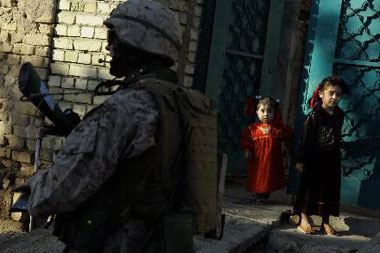
>> This series makes me realize how typical (and easy?) it is for
news photographers in Iraq to photograph children without adults.
>>Of the pictures I’ve previously seen of mothers and
children, most tend to reflect a tone of acquiescence. Perhaps its
because the photographer and the troops are literally in these people’s
back yards, but #17 and #19 (mothers walking by soldiers with children;
children entering courtyard) reveal a great deal of expression (cold
suspicion, primarily) on the part of the women.
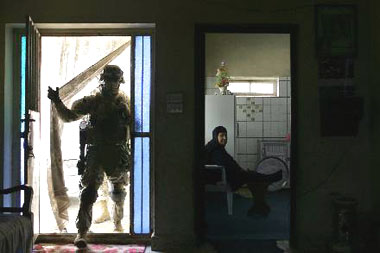
>> As you probably know, I’ve been interested in these
images of home raids since the war began. I wonder why photographers
have such a tendency to shoot them, and what the ethics are in allowing
the photographer into the house with the soldiers. I also wonder how
much the presence of the photographer tends to either mitigate or
exacerbate the experience for the resident.
What’s unique about the fifth picture (Iraqi man in bedroom
locating identification) is that we’ve already become acquainted with
Lance Corporal de Carvalho. Because the Iraqi man is occupied, what
the photographer, Mr. Lima, has created is a rare posed portrait in the
midst of a raid. What is Mr. de Carvalho thinking standing there with
that enormous gun? How much does he form a youthful bookend with the
young boy hanging on the wall? Why does it not seem unusual that these
suitcases comprise such a prominent feature?
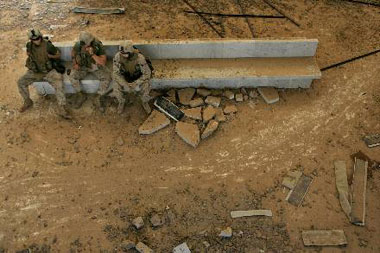
>> This perception might not be accurate, but it seems
there is a well-worn path these soldiers follow into, through and out
of town. Is the route marked off (in early shots, across field) to
guard against stepping on an explosive device? When I see the soldiers
cooped up at the beginning and fencing themselves in at the end, then I
see how the Iraqis are sealed in, it seems the sense of containment
must be mind numbing to everyone involved.
>> Wishful thinking, perhaps, but the colorful vegetable stand seems to spell hope.
(image 1 – 4: Mauricio Lima/AFP/Getty. December 20, 19, 19 and 18, 2005; Fallujah, Iraq. crisispictures.org.)
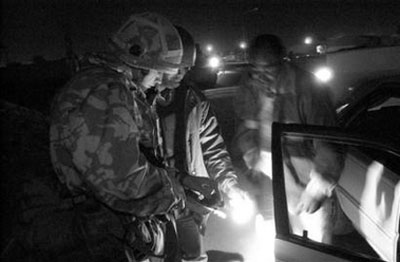
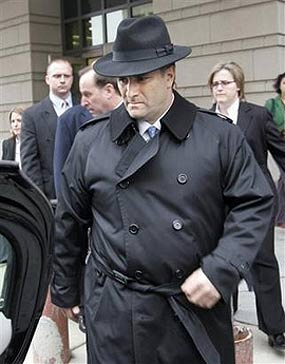
Reactions
Comments Powered by Disqus